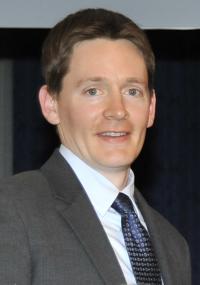Jan 25 2014
Dr. Jeremy Robinson of the U.S. Naval Research Laboratory (NRL) is a recipient of the 2012 Presidential Early Career Awards for Scientists and Engineers (PECASE).
 "The work is a creative outlet, and that is the driver for me going to the lab," says Dr. Jeremy Robinson, a material scientist who recently won an award from the President for his early career work at the US Naval Research Laboratory. Credit: Photo courtesy of US Naval Research Laboratory
"The work is a creative outlet, and that is the driver for me going to the lab," says Dr. Jeremy Robinson, a material scientist who recently won an award from the President for his early career work at the US Naval Research Laboratory. Credit: Photo courtesy of US Naval Research Laboratory
Robinson studies graphene, a carbon nanomaterial. He's looking at how it can be used to detect chemicals, and how its electronic and mechanical properties can be used for nanoelectronic and radio frequency communication applications.
Robinson joined NRL as a postdoc in 2007 after his older brother, Dr. Josh Robinson, also did his postdoc here: "In fact, my brother sat at this desk," Robinson says with a laugh. "We are always in friendly competition. So this [Presidential award] is the latest feather in my cap."
The older Robinson had demonstrated that adding defects to carbon nanotubes makes them better chemical sensors (he's since joined the faculty at Penn State). The younger Robinson, who joined the fulltime NRL staff in 2008, sees his early work as building on his brother's. Instead of working with carbon atoms bonded in the shape of a tube, however, he studies carbon in a flat sheet. "Things worked out smashingly well," he says, "so it took off from there."
Robinson brings a materials science perspective to his current research, connecting material synthesis, material properties, and applications. The best chemical sensors are those that offer both sensitivity and specificity: "Designing graphene with specific defects is an ideal way to engineer its properties and potentially improve its sensor response."
Taking graphene, he introduces an atom of a different chemical species, like oxygen or fluorine. He'll then test sensor capability, mechanical strength, or optical properties. "We continue to be surprised about the range of interesting experiments and results," he says.
The White House announced the 102 award recipients on December 23, 2013. "We are grateful for their commitment to generating the scientific and technical advancements that will ensure America's global leadership for many years to come," said President Obama.
The first call Robinson made was to his dad; the second, to his brother.
Robinson sees major awards like this one as a way to achieve recognition amid a competitive field. He hopes it will help his work attract interest and funding, which in turn may lead to more breakthroughs and publications.
But recognition for its own sake is not his goal, he says. "The work is a creative outlet, and that is the driver for me going to the lab. It's very nice when those two meet up, in that your creative outlet can be recognized with an award like this. It feels very special."
Robinson credits collaboration across the NRL campus as essential to his early success. "I might talk to my postdoc advisor [Dr. Eric Snow] about this kind of problem. And he says, 'You should go talk to Paul in chemistry. You should go talk to Maxim in acoustics.' I think a lot of the interesting, new discoveries happen at those interfaces."
At NRL, he has become more connected to how his research improves technologies. "It's clear that you can't just survive on the core sciences alone here, you have to make yourself relevant for these end applications. I've shifted my thinking and efforts as best I can to plug into the application space of the Navy and Marine Corps. When I'm doing basic research, I'm thinking, how does it connect to sensing or electronics or mechanical systems?"
Robinson grew up in Friendsville, a town of 500 in western Maryland. Math always came to him easily, but it wasn't until his undergrad at Towson University that he became interested in materials science.
Working toward his 2007 PhD at UC Berkeley, he built on his technical knowledge by studying how nature organizes materials at the nanoscale and the properties that arise (with germanium, in particular): "There's two strategies to go very small: one is with a hammer and chisel; a more elegant way is to convince nature to grow you something very small, exactly where you want it." He also learned the communication and collaboration skills that would help him thrive at NRL: "Going to conferences, writing papers—these are critical to help people learn."
Robinson's very excited to go to the White House, and in fact admitted to going suit shopping this weekend. "I grew up in a very rural area and of course it's a nice thing to have someone from your community receive an award like this. I imagine it will be in the local paper soon."
Robinson has also published over 60 peer-reviewed journal articles, holds one patent, and is a four-time winner of the Alan Berman Research Publication Award. And as for the sibling rivalry? "Our families got together this past weekend, and my brother brought a paper crown for me to wear. So he has a sense of humor about it."
This marks the third year in a row an NRL researcher has won a PECASE.